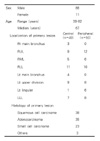1. Cortese DA, Pairolero PC, Bergstalh EJ, Woolner LB, Uhlenhopp MA, Piehler JM, et al. Roentgenographically occult lung cancer: a ten-year experience. J Thorac Cardiovasc Surg. 1983. 86:373–380.
2. Woolner LB, Fontana RS, Cortese DA, Sanderson DR, Bernatz PE, Payne WS, et al. Roentgenographically occult lung cancer: pathologic findings and frequency of multicentricity during a ten-year period. Mayo Clin Proc. 1984. 59:453–466.
4. Saito Y, Nagamoto N, Ota S, Sato M, Sagawa M, Kamma K, et al. Results of surgical treatment for roentgenographically occult bronchogenic squamous cell carcinoma. J Thorac Cardiovasc Surg. 1992. 104:401–407.
5. Lam S, MacAulay C, Hung J, LeRiche J, Profio AE, Palcic B. Detection of dysplasia and carcinoma in situ with a lung imaging fluorescence endoscope device. J Thorac Cardiovasc Surg. 1993. 105:1035–1040.
6. Antakli T, Schaefer RF, Rutherford JE, Read RC. Second primary lung cancer. Ann Thorac Surg. 1995. 59:863–867.
7. Okada M, Tsubota N, Yoshimura M, Miyamoto Y. Operative approach for multiple primary lung carcinomas. J Thorac Cardiovasc Surg. 1998. 115:836–840.
8. Johnson BE, Cortazar P, Chute JP. Second lung cancers in patients successfully treated for lung cancer. Semin Oncol. 1997. 24:492–499.
9. Lam S, MacAulay C, LeRiche JC, Palcic B. Detection and localization of early lung cancer by fluorescence bronchoscopy. Cancer. 2000. 89:2468–2473.
10. Sutedja TG, Codrington H, Risse EK, Breuer RH, van Mourik JC, Golding RP, et al. Autofluorescence bronchoscopy improves staging of radiographically occult lung cancer and has an impact on therapeutic strategy. Chest. 2001. 120:1327–1332.
11. Pierard P, Faber J, Hutsebaut J, Martin B, Plat G, Sculier JP, et al. Synchronous lesions detected by autofluorescence bronchoscopy in patients with high-grade preinvasive lesions and occult invasive squamous cell carcinoma of the proximal airways. Lung Cancer. 2004. 46:341–347.
12. Pierard P, Vermylen P, Bosschaerts T, Roufosse C, Berghmans T, Sculier JP, et al. Synchronous roentgenographically occult lung carcinoma in patients with resectable primary lung cancer. Chest. 2000. 117:779–785.
13. van Rens MT, Schramel FM, Elbers JR, Lammers JW. The clinical value of lung imaging fluorescence endoscopy for detecting synchronous lung cancer. Lung Cancer. 2001. 32:13–18.
14. Brambilla E, Travis WD, Colby TV, Corrin B, Shimosato Y. The new World Health Organization classification of lung tumours. Eur Respir J. 2001. 18:1059–1068.
15. Martini N, Melamed MR. Multiple primary lung cancers. J Thorac Cardiovasc Surg. 1975. 70:606–612.
16. van Rens MT, Zanen P, Brutel de La Riviere A, Elbers HR, van Swieten HA, van den Bosch JM. Survival in synchronous vs. single lung cancer: upstaging better reflects prognosis. Chest. 2000. 118:952–958.
17. Detterbeck FC, Jones DR, Kernstine KH, Naunheim KS. Lung cancer: special treatment issues. Chest. 2003. 123:Suppl. 244S–258S.
18. Hiroshima K, Toyozaki T, Kohno H, Ohwada H, Fujisawa T. Synchronous and metachronous lung carcinomas: molecular evidence for multicentricity. Pathol Int. 1998. 48:869–876.
19. Kunitoh H, Eguchi K, Yamada K, Tsuchiya R, Kaneko M, Moriyama N, et al. Intrapulmonary sublesions detected before surgery in patients with lung cancer. Cancer. 1992. 70:1876–1879.
20. Bechtel JJ, Kelley WR, Petty TL, Patz DS, Saccomanno G. Outcome of 51 patients with roentgenographically occult lung cancer detected by sputum cytologic testing: a community hospital program. Arch Intern Med. 1994. 154:975–980.
21. Slaughter DP, Sothwick HW, Smejkal W. Field cancerization in oral stratified squamous epithelium: clinical implications of multicentric origin. Cancer. 1953. 6:963–968.
22. Paci M, Sgarbi G, Ferrari G, de Franco S, Annessi V. Controversies over UICC-TNM classification of non-small cell lung cancer: model for a diagnostic path. Chest. 2002. 122:754.







 PDF
PDF ePub
ePub Citation
Citation Print
Print




 XML Download
XML Download